Report: Legal and Regulatory Frameworks in Community Services
VerifiedAdded on 2022/09/23
|11
|1985
|28
Report
AI Summary
This report provides a detailed analysis of legal and regulatory frameworks within the context of community services. It begins by defining policy and exploring its purpose, as well as its role in shaping the community service sector. The report then delves into the critical issue of child protection, examining the consequences of failing to protect vulnerable individuals and the responsibilities of relevant organizations and authorized persons. Finally, the report addresses client rights, offering insights into the rights of service providers, clients, their families, and the community. The report concludes by emphasizing the significance of these frameworks in fostering community development and upholding the rights and duties of individuals and groups within the sector.
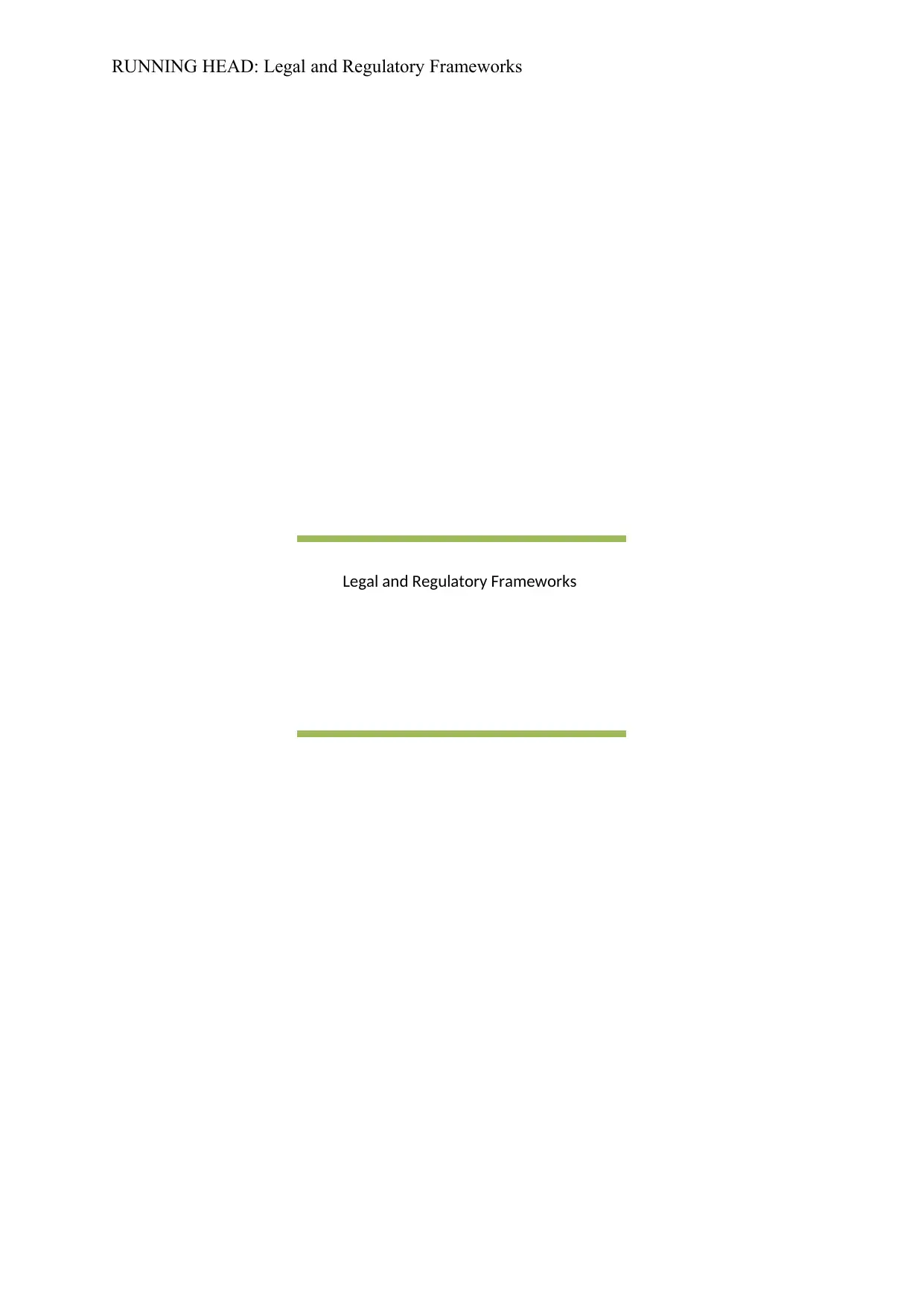
RUNNING HEAD: Legal and Regulatory Frameworks
Legal and Regulatory Frameworks
Legal and Regulatory Frameworks
Paraphrase This Document
Need a fresh take? Get an instant paraphrase of this document with our AI Paraphraser
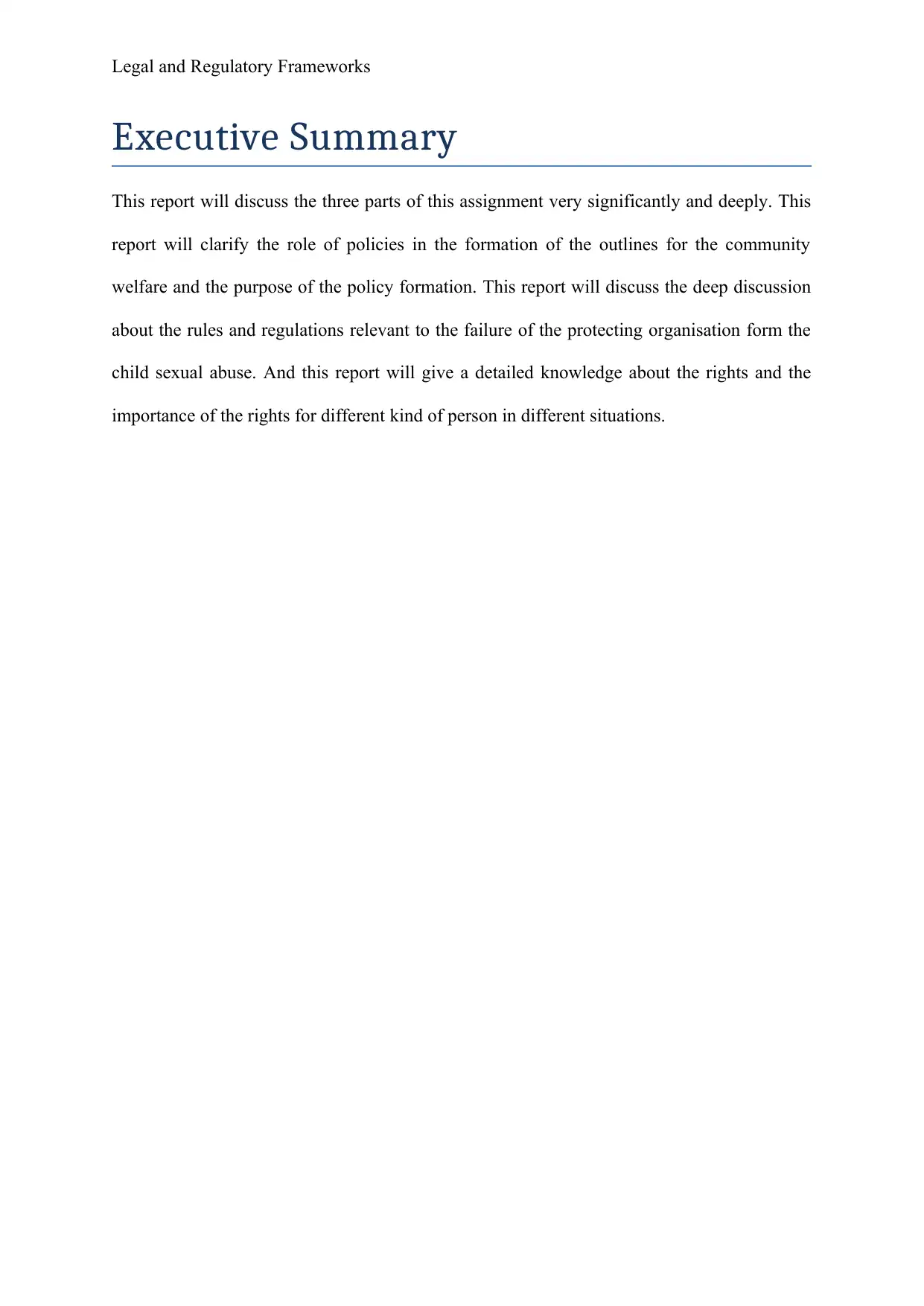
Legal and Regulatory Frameworks
Executive Summary
This report will discuss the three parts of this assignment very significantly and deeply. This
report will clarify the role of policies in the formation of the outlines for the community
welfare and the purpose of the policy formation. This report will discuss the deep discussion
about the rules and regulations relevant to the failure of the protecting organisation form the
child sexual abuse. And this report will give a detailed knowledge about the rights and the
importance of the rights for different kind of person in different situations.
Executive Summary
This report will discuss the three parts of this assignment very significantly and deeply. This
report will clarify the role of policies in the formation of the outlines for the community
welfare and the purpose of the policy formation. This report will discuss the deep discussion
about the rules and regulations relevant to the failure of the protecting organisation form the
child sexual abuse. And this report will give a detailed knowledge about the rights and the
importance of the rights for different kind of person in different situations.
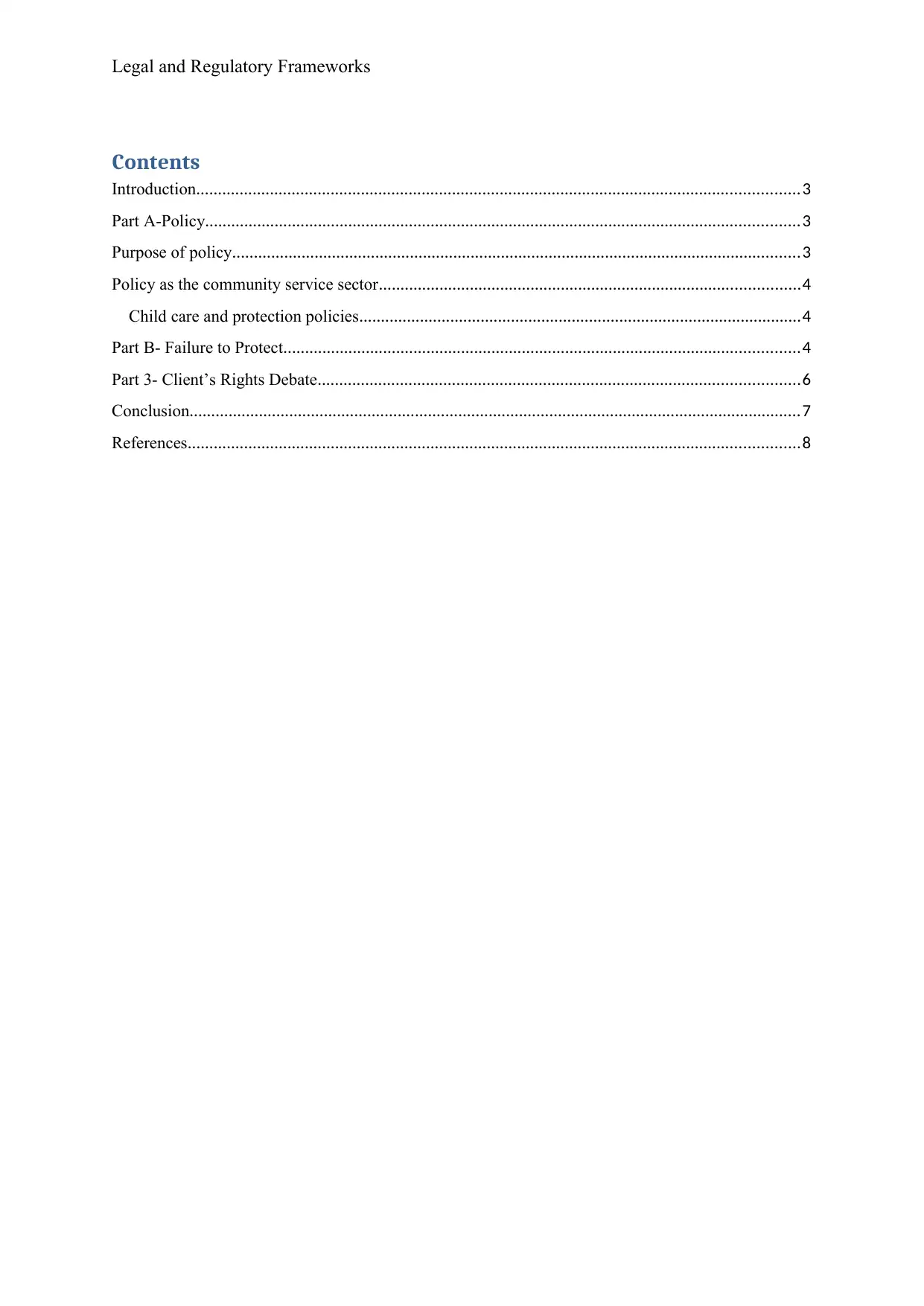
Legal and Regulatory Frameworks
Contents
Introduction...........................................................................................................................................3
Part A-Policy.........................................................................................................................................3
Purpose of policy...................................................................................................................................3
Policy as the community service sector.................................................................................................4
Child care and protection policies......................................................................................................4
Part B- Failure to Protect.......................................................................................................................4
Part 3- Client’s Rights Debate...............................................................................................................6
Conclusion.............................................................................................................................................7
References.............................................................................................................................................8
Contents
Introduction...........................................................................................................................................3
Part A-Policy.........................................................................................................................................3
Purpose of policy...................................................................................................................................3
Policy as the community service sector.................................................................................................4
Child care and protection policies......................................................................................................4
Part B- Failure to Protect.......................................................................................................................4
Part 3- Client’s Rights Debate...............................................................................................................6
Conclusion.............................................................................................................................................7
References.............................................................................................................................................8
⊘ This is a preview!⊘
Do you want full access?
Subscribe today to unlock all pages.

Trusted by 1+ million students worldwide
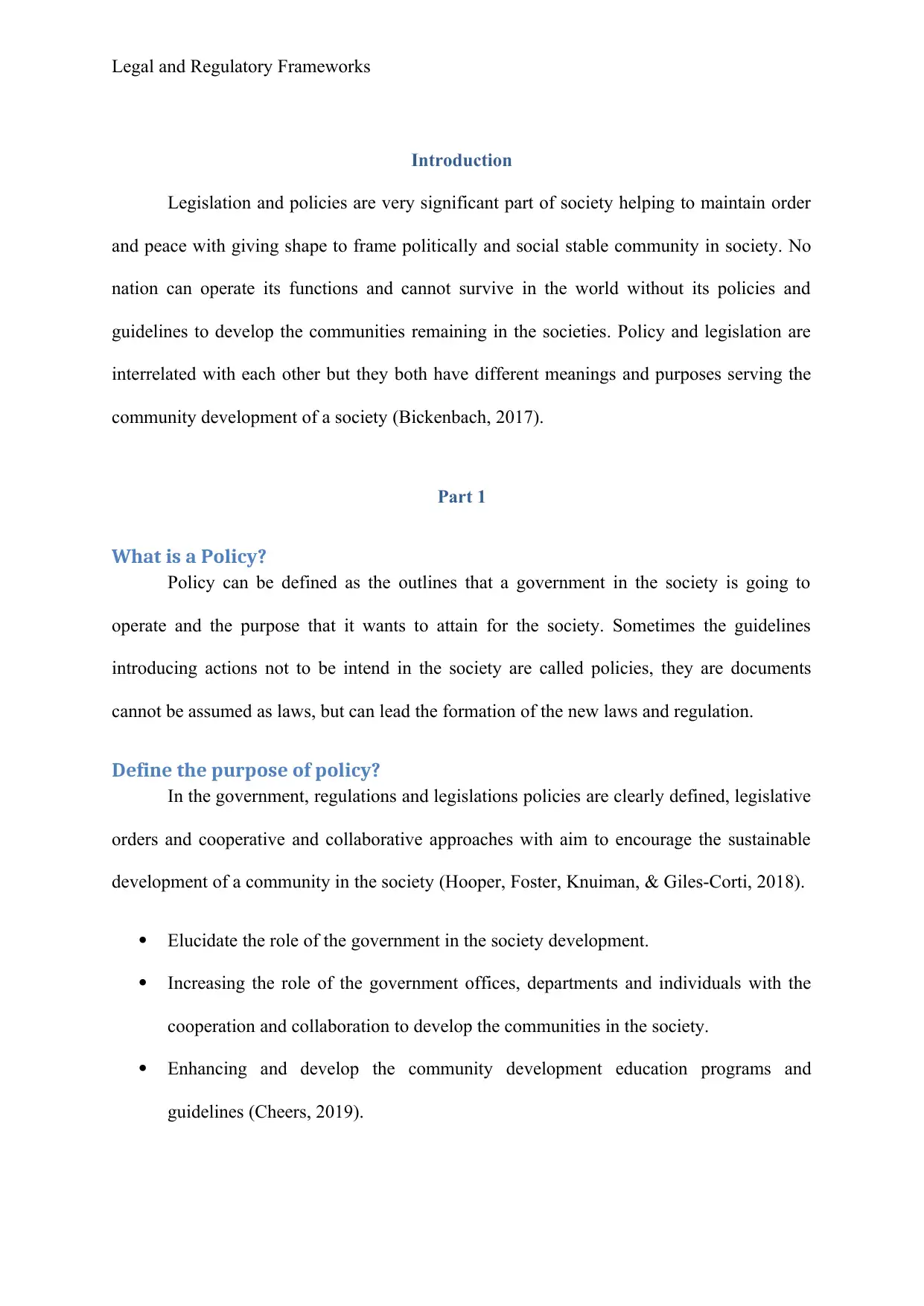
Legal and Regulatory Frameworks
Introduction
Legislation and policies are very significant part of society helping to maintain order
and peace with giving shape to frame politically and social stable community in society. No
nation can operate its functions and cannot survive in the world without its policies and
guidelines to develop the communities remaining in the societies. Policy and legislation are
interrelated with each other but they both have different meanings and purposes serving the
community development of a society (Bickenbach, 2017).
Part 1
What is a Policy?
Policy can be defined as the outlines that a government in the society is going to
operate and the purpose that it wants to attain for the society. Sometimes the guidelines
introducing actions not to be intend in the society are called policies, they are documents
cannot be assumed as laws, but can lead the formation of the new laws and regulation.
Define the purpose of policy?
In the government, regulations and legislations policies are clearly defined, legislative
orders and cooperative and collaborative approaches with aim to encourage the sustainable
development of a community in the society (Hooper, Foster, Knuiman, & Giles-Corti, 2018).
Elucidate the role of the government in the society development.
Increasing the role of the government offices, departments and individuals with the
cooperation and collaboration to develop the communities in the society.
Enhancing and develop the community development education programs and
guidelines (Cheers, 2019).
Introduction
Legislation and policies are very significant part of society helping to maintain order
and peace with giving shape to frame politically and social stable community in society. No
nation can operate its functions and cannot survive in the world without its policies and
guidelines to develop the communities remaining in the societies. Policy and legislation are
interrelated with each other but they both have different meanings and purposes serving the
community development of a society (Bickenbach, 2017).
Part 1
What is a Policy?
Policy can be defined as the outlines that a government in the society is going to
operate and the purpose that it wants to attain for the society. Sometimes the guidelines
introducing actions not to be intend in the society are called policies, they are documents
cannot be assumed as laws, but can lead the formation of the new laws and regulation.
Define the purpose of policy?
In the government, regulations and legislations policies are clearly defined, legislative
orders and cooperative and collaborative approaches with aim to encourage the sustainable
development of a community in the society (Hooper, Foster, Knuiman, & Giles-Corti, 2018).
Elucidate the role of the government in the society development.
Increasing the role of the government offices, departments and individuals with the
cooperation and collaboration to develop the communities in the society.
Enhancing and develop the community development education programs and
guidelines (Cheers, 2019).
Paraphrase This Document
Need a fresh take? Get an instant paraphrase of this document with our AI Paraphraser
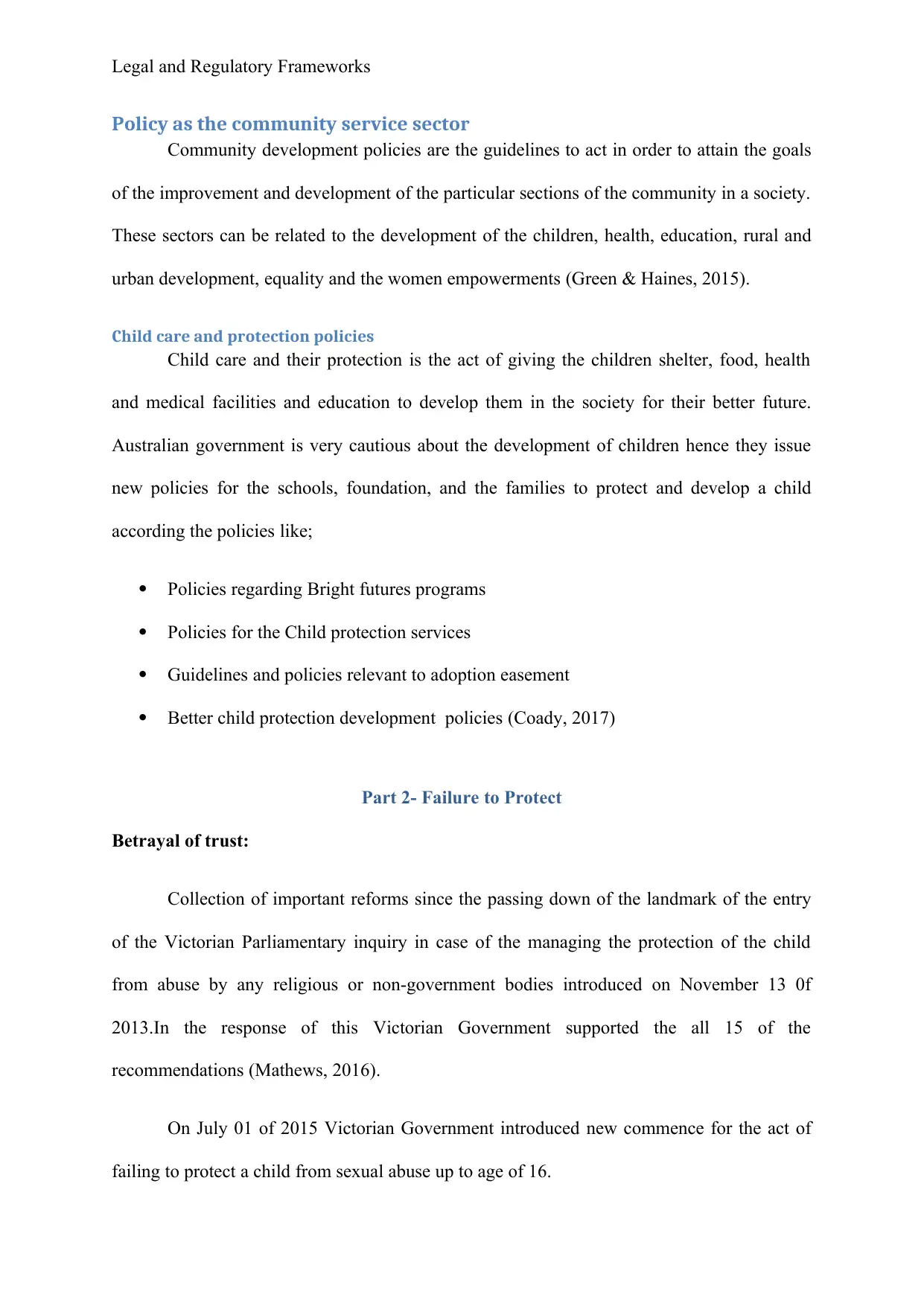
Legal and Regulatory Frameworks
Policy as the community service sector
Community development policies are the guidelines to act in order to attain the goals
of the improvement and development of the particular sections of the community in a society.
These sectors can be related to the development of the children, health, education, rural and
urban development, equality and the women empowerments (Green & Haines, 2015).
Child care and protection policies
Child care and their protection is the act of giving the children shelter, food, health
and medical facilities and education to develop them in the society for their better future.
Australian government is very cautious about the development of children hence they issue
new policies for the schools, foundation, and the families to protect and develop a child
according the policies like;
Policies regarding Bright futures programs
Policies for the Child protection services
Guidelines and policies relevant to adoption easement
Better child protection development policies (Coady, 2017)
Part 2- Failure to Protect
Betrayal of trust:
Collection of important reforms since the passing down of the landmark of the entry
of the Victorian Parliamentary inquiry in case of the managing the protection of the child
from abuse by any religious or non-government bodies introduced on November 13 0f
2013.In the response of this Victorian Government supported the all 15 of the
recommendations (Mathews, 2016).
On July 01 of 2015 Victorian Government introduced new commence for the act of
failing to protect a child from sexual abuse up to age of 16.
Policy as the community service sector
Community development policies are the guidelines to act in order to attain the goals
of the improvement and development of the particular sections of the community in a society.
These sectors can be related to the development of the children, health, education, rural and
urban development, equality and the women empowerments (Green & Haines, 2015).
Child care and protection policies
Child care and their protection is the act of giving the children shelter, food, health
and medical facilities and education to develop them in the society for their better future.
Australian government is very cautious about the development of children hence they issue
new policies for the schools, foundation, and the families to protect and develop a child
according the policies like;
Policies regarding Bright futures programs
Policies for the Child protection services
Guidelines and policies relevant to adoption easement
Better child protection development policies (Coady, 2017)
Part 2- Failure to Protect
Betrayal of trust:
Collection of important reforms since the passing down of the landmark of the entry
of the Victorian Parliamentary inquiry in case of the managing the protection of the child
from abuse by any religious or non-government bodies introduced on November 13 0f
2013.In the response of this Victorian Government supported the all 15 of the
recommendations (Mathews, 2016).
On July 01 of 2015 Victorian Government introduced new commence for the act of
failing to protect a child from sexual abuse up to age of 16.
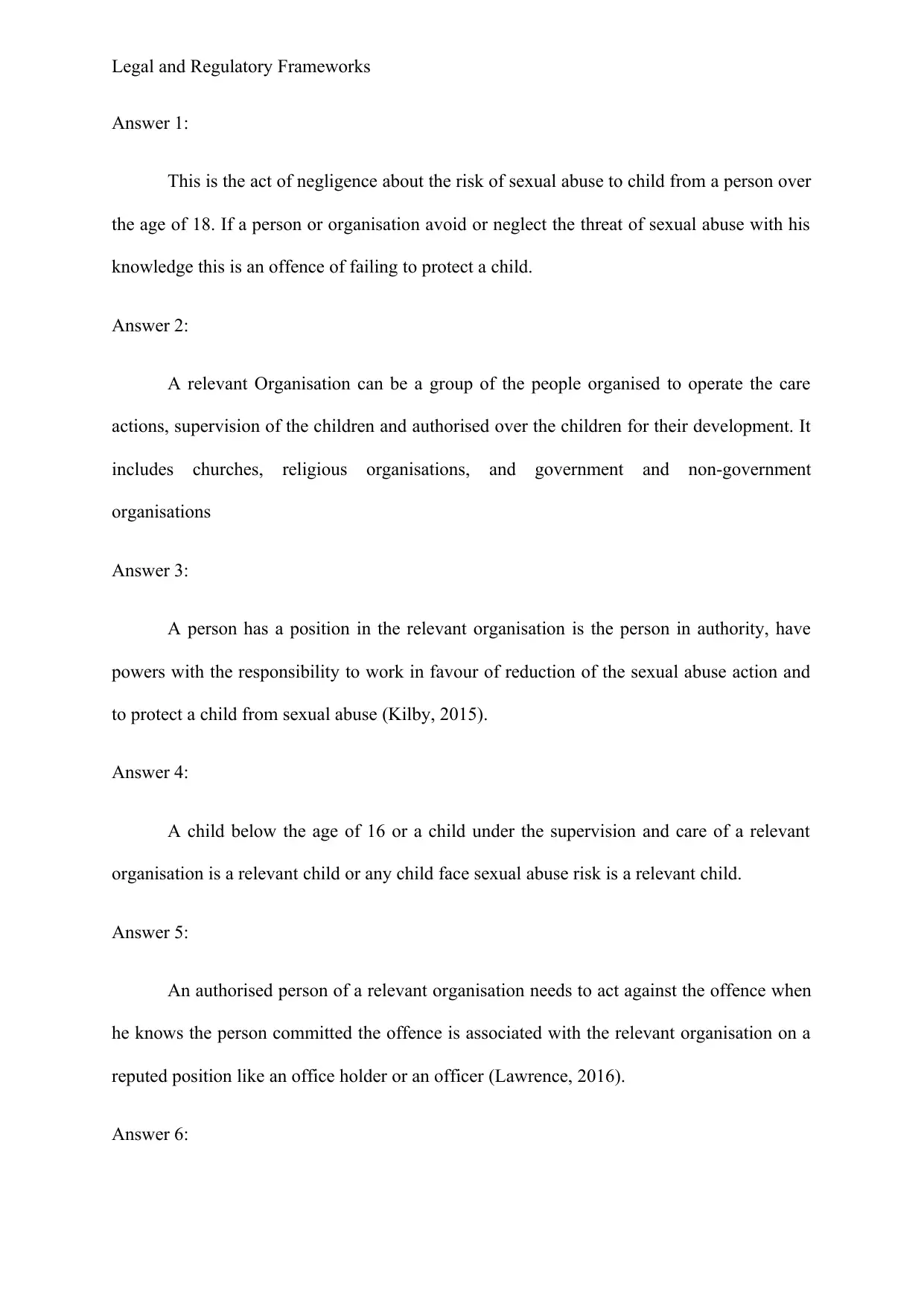
Legal and Regulatory Frameworks
Answer 1:
This is the act of negligence about the risk of sexual abuse to child from a person over
the age of 18. If a person or organisation avoid or neglect the threat of sexual abuse with his
knowledge this is an offence of failing to protect a child.
Answer 2:
A relevant Organisation can be a group of the people organised to operate the care
actions, supervision of the children and authorised over the children for their development. It
includes churches, religious organisations, and government and non-government
organisations
Answer 3:
A person has a position in the relevant organisation is the person in authority, have
powers with the responsibility to work in favour of reduction of the sexual abuse action and
to protect a child from sexual abuse (Kilby, 2015).
Answer 4:
A child below the age of 16 or a child under the supervision and care of a relevant
organisation is a relevant child or any child face sexual abuse risk is a relevant child.
Answer 5:
An authorised person of a relevant organisation needs to act against the offence when
he knows the person committed the offence is associated with the relevant organisation on a
reputed position like an office holder or an officer (Lawrence, 2016).
Answer 6:
Answer 1:
This is the act of negligence about the risk of sexual abuse to child from a person over
the age of 18. If a person or organisation avoid or neglect the threat of sexual abuse with his
knowledge this is an offence of failing to protect a child.
Answer 2:
A relevant Organisation can be a group of the people organised to operate the care
actions, supervision of the children and authorised over the children for their development. It
includes churches, religious organisations, and government and non-government
organisations
Answer 3:
A person has a position in the relevant organisation is the person in authority, have
powers with the responsibility to work in favour of reduction of the sexual abuse action and
to protect a child from sexual abuse (Kilby, 2015).
Answer 4:
A child below the age of 16 or a child under the supervision and care of a relevant
organisation is a relevant child or any child face sexual abuse risk is a relevant child.
Answer 5:
An authorised person of a relevant organisation needs to act against the offence when
he knows the person committed the offence is associated with the relevant organisation on a
reputed position like an office holder or an officer (Lawrence, 2016).
Answer 6:
⊘ This is a preview!⊘
Do you want full access?
Subscribe today to unlock all pages.

Trusted by 1+ million students worldwide
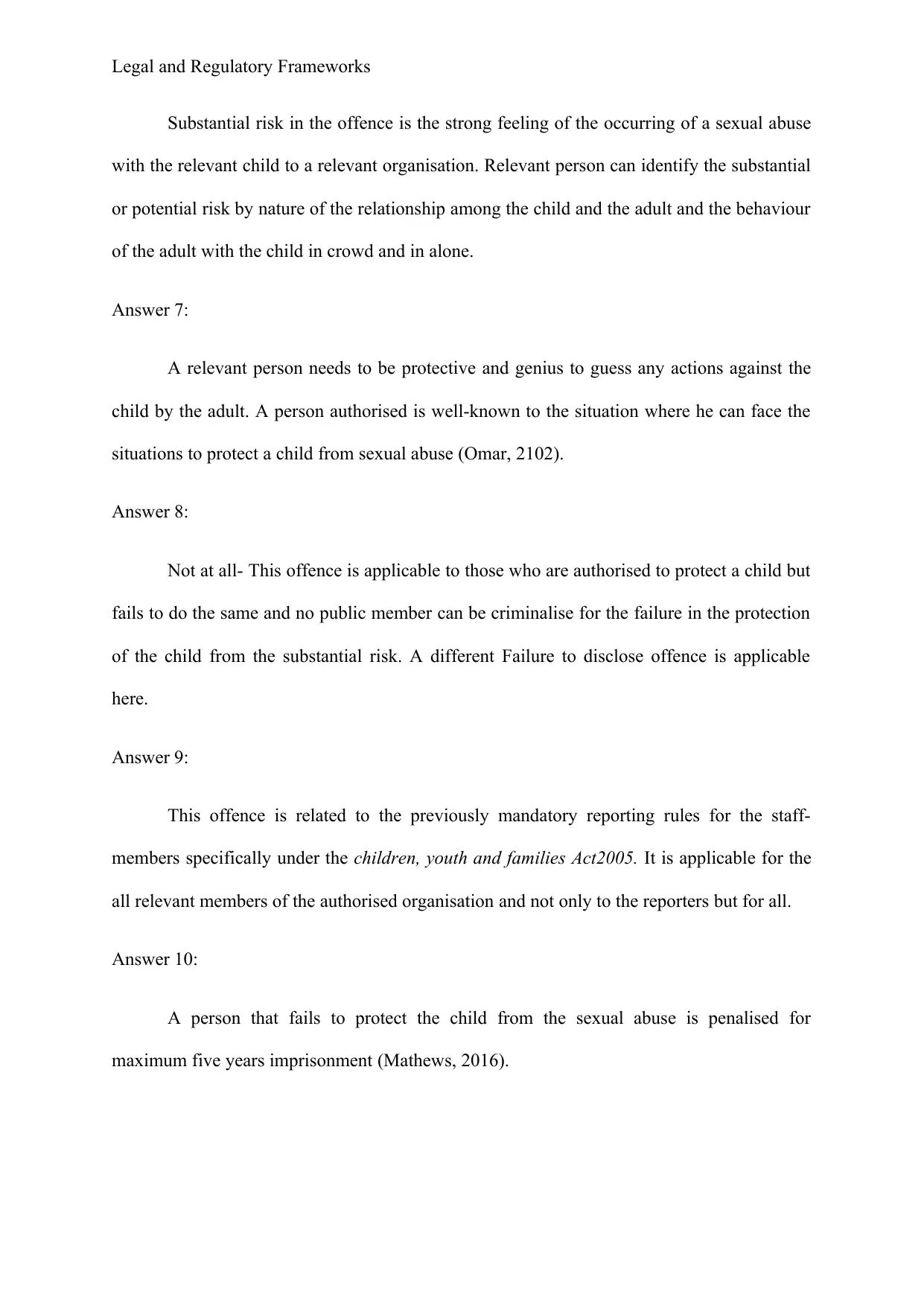
Legal and Regulatory Frameworks
Substantial risk in the offence is the strong feeling of the occurring of a sexual abuse
with the relevant child to a relevant organisation. Relevant person can identify the substantial
or potential risk by nature of the relationship among the child and the adult and the behaviour
of the adult with the child in crowd and in alone.
Answer 7:
A relevant person needs to be protective and genius to guess any actions against the
child by the adult. A person authorised is well-known to the situation where he can face the
situations to protect a child from sexual abuse (Omar, 2102).
Answer 8:
Not at all- This offence is applicable to those who are authorised to protect a child but
fails to do the same and no public member can be criminalise for the failure in the protection
of the child from the substantial risk. A different Failure to disclose offence is applicable
here.
Answer 9:
This offence is related to the previously mandatory reporting rules for the staff-
members specifically under the children, youth and families Act2005. It is applicable for the
all relevant members of the authorised organisation and not only to the reporters but for all.
Answer 10:
A person that fails to protect the child from the sexual abuse is penalised for
maximum five years imprisonment (Mathews, 2016).
Substantial risk in the offence is the strong feeling of the occurring of a sexual abuse
with the relevant child to a relevant organisation. Relevant person can identify the substantial
or potential risk by nature of the relationship among the child and the adult and the behaviour
of the adult with the child in crowd and in alone.
Answer 7:
A relevant person needs to be protective and genius to guess any actions against the
child by the adult. A person authorised is well-known to the situation where he can face the
situations to protect a child from sexual abuse (Omar, 2102).
Answer 8:
Not at all- This offence is applicable to those who are authorised to protect a child but
fails to do the same and no public member can be criminalise for the failure in the protection
of the child from the substantial risk. A different Failure to disclose offence is applicable
here.
Answer 9:
This offence is related to the previously mandatory reporting rules for the staff-
members specifically under the children, youth and families Act2005. It is applicable for the
all relevant members of the authorised organisation and not only to the reporters but for all.
Answer 10:
A person that fails to protect the child from the sexual abuse is penalised for
maximum five years imprisonment (Mathews, 2016).
Paraphrase This Document
Need a fresh take? Get an instant paraphrase of this document with our AI Paraphraser
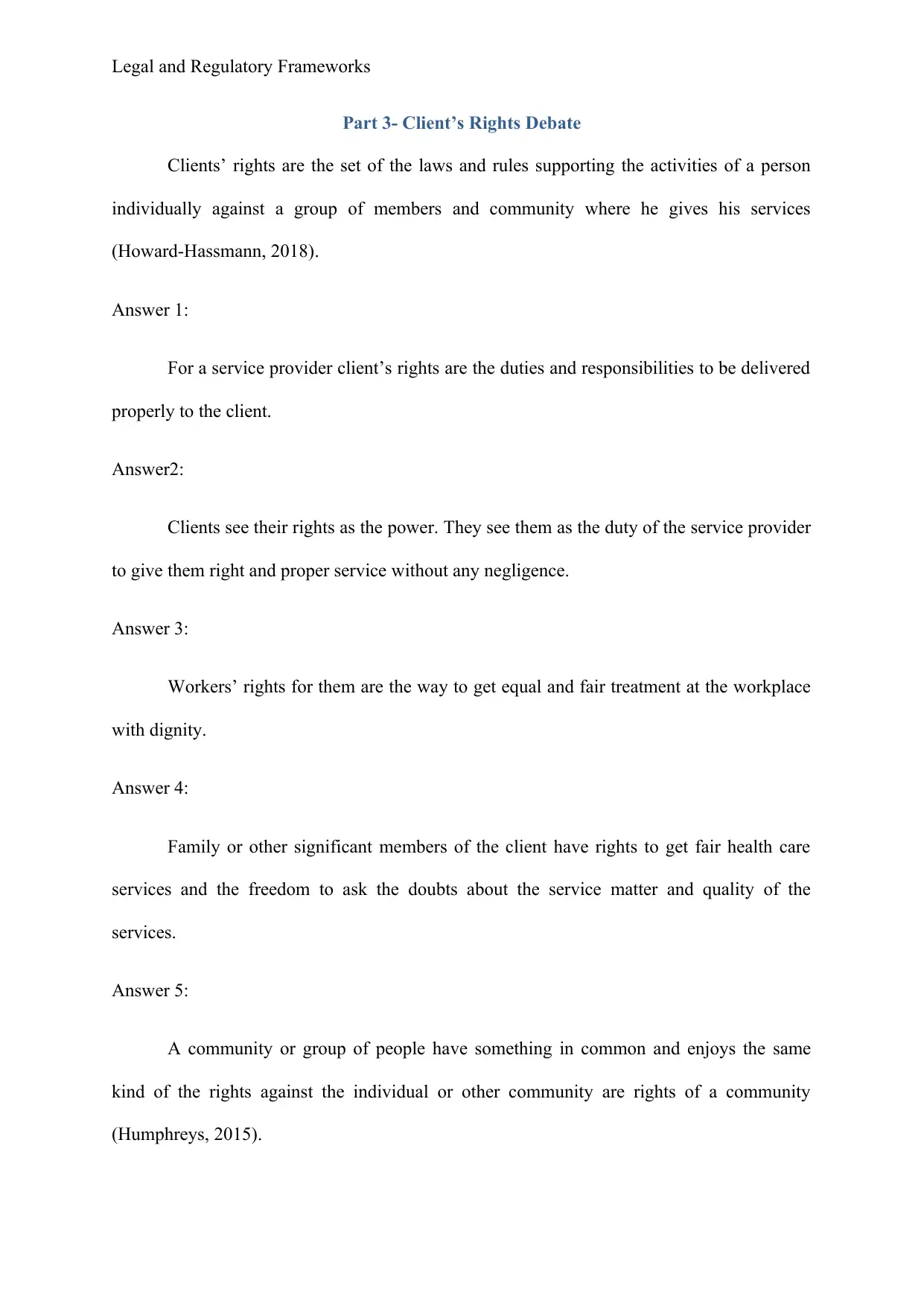
Legal and Regulatory Frameworks
Part 3- Client’s Rights Debate
Clients’ rights are the set of the laws and rules supporting the activities of a person
individually against a group of members and community where he gives his services
(Howard-Hassmann, 2018).
Answer 1:
For a service provider client’s rights are the duties and responsibilities to be delivered
properly to the client.
Answer2:
Clients see their rights as the power. They see them as the duty of the service provider
to give them right and proper service without any negligence.
Answer 3:
Workers’ rights for them are the way to get equal and fair treatment at the workplace
with dignity.
Answer 4:
Family or other significant members of the client have rights to get fair health care
services and the freedom to ask the doubts about the service matter and quality of the
services.
Answer 5:
A community or group of people have something in common and enjoys the same
kind of the rights against the individual or other community are rights of a community
(Humphreys, 2015).
Part 3- Client’s Rights Debate
Clients’ rights are the set of the laws and rules supporting the activities of a person
individually against a group of members and community where he gives his services
(Howard-Hassmann, 2018).
Answer 1:
For a service provider client’s rights are the duties and responsibilities to be delivered
properly to the client.
Answer2:
Clients see their rights as the power. They see them as the duty of the service provider
to give them right and proper service without any negligence.
Answer 3:
Workers’ rights for them are the way to get equal and fair treatment at the workplace
with dignity.
Answer 4:
Family or other significant members of the client have rights to get fair health care
services and the freedom to ask the doubts about the service matter and quality of the
services.
Answer 5:
A community or group of people have something in common and enjoys the same
kind of the rights against the individual or other community are rights of a community
(Humphreys, 2015).
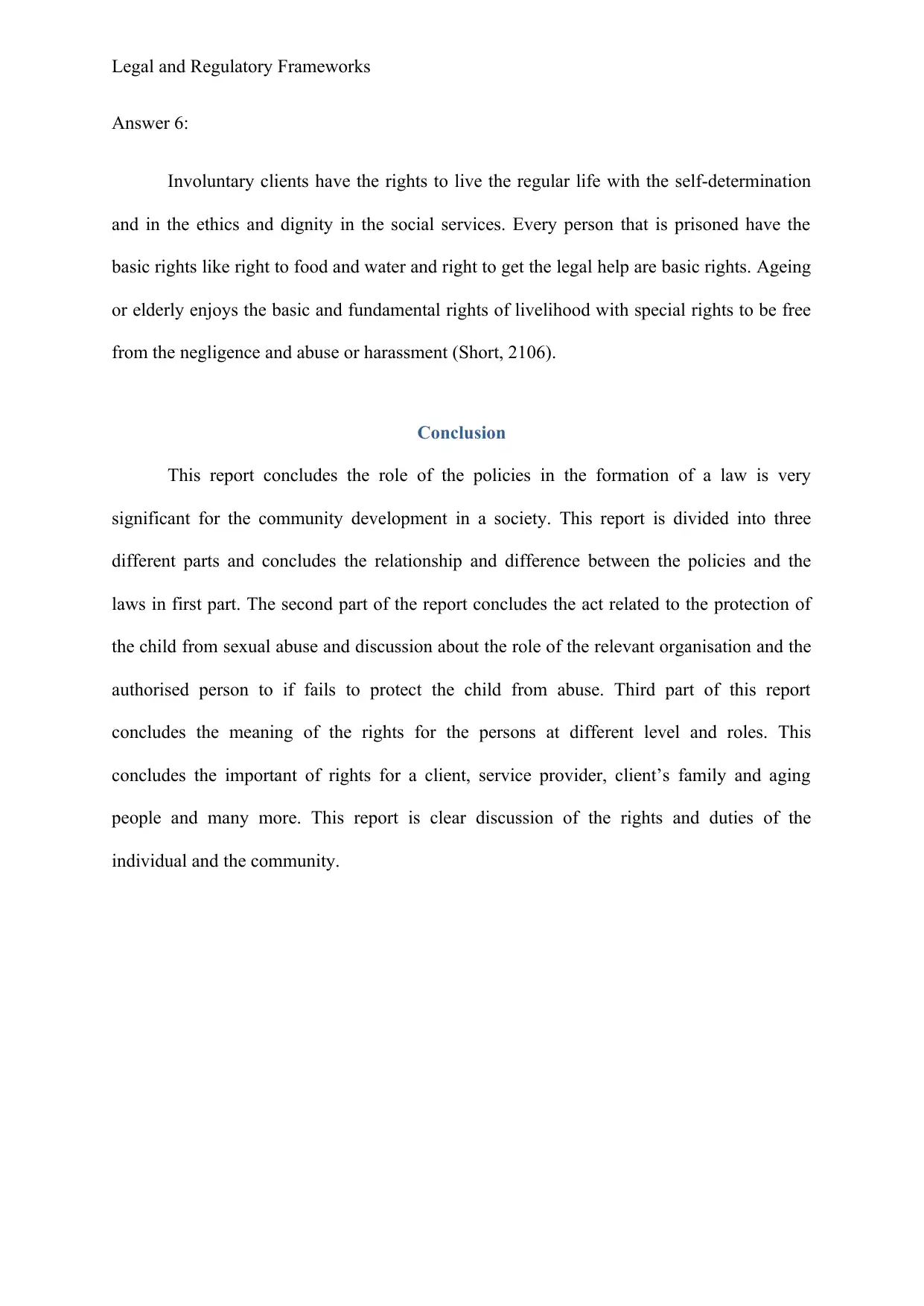
Legal and Regulatory Frameworks
Answer 6:
Involuntary clients have the rights to live the regular life with the self-determination
and in the ethics and dignity in the social services. Every person that is prisoned have the
basic rights like right to food and water and right to get the legal help are basic rights. Ageing
or elderly enjoys the basic and fundamental rights of livelihood with special rights to be free
from the negligence and abuse or harassment (Short, 2106).
Conclusion
This report concludes the role of the policies in the formation of a law is very
significant for the community development in a society. This report is divided into three
different parts and concludes the relationship and difference between the policies and the
laws in first part. The second part of the report concludes the act related to the protection of
the child from sexual abuse and discussion about the role of the relevant organisation and the
authorised person to if fails to protect the child from abuse. Third part of this report
concludes the meaning of the rights for the persons at different level and roles. This
concludes the important of rights for a client, service provider, client’s family and aging
people and many more. This report is clear discussion of the rights and duties of the
individual and the community.
Answer 6:
Involuntary clients have the rights to live the regular life with the self-determination
and in the ethics and dignity in the social services. Every person that is prisoned have the
basic rights like right to food and water and right to get the legal help are basic rights. Ageing
or elderly enjoys the basic and fundamental rights of livelihood with special rights to be free
from the negligence and abuse or harassment (Short, 2106).
Conclusion
This report concludes the role of the policies in the formation of a law is very
significant for the community development in a society. This report is divided into three
different parts and concludes the relationship and difference between the policies and the
laws in first part. The second part of the report concludes the act related to the protection of
the child from sexual abuse and discussion about the role of the relevant organisation and the
authorised person to if fails to protect the child from abuse. Third part of this report
concludes the meaning of the rights for the persons at different level and roles. This
concludes the important of rights for a client, service provider, client’s family and aging
people and many more. This report is clear discussion of the rights and duties of the
individual and the community.
⊘ This is a preview!⊘
Do you want full access?
Subscribe today to unlock all pages.

Trusted by 1+ million students worldwide
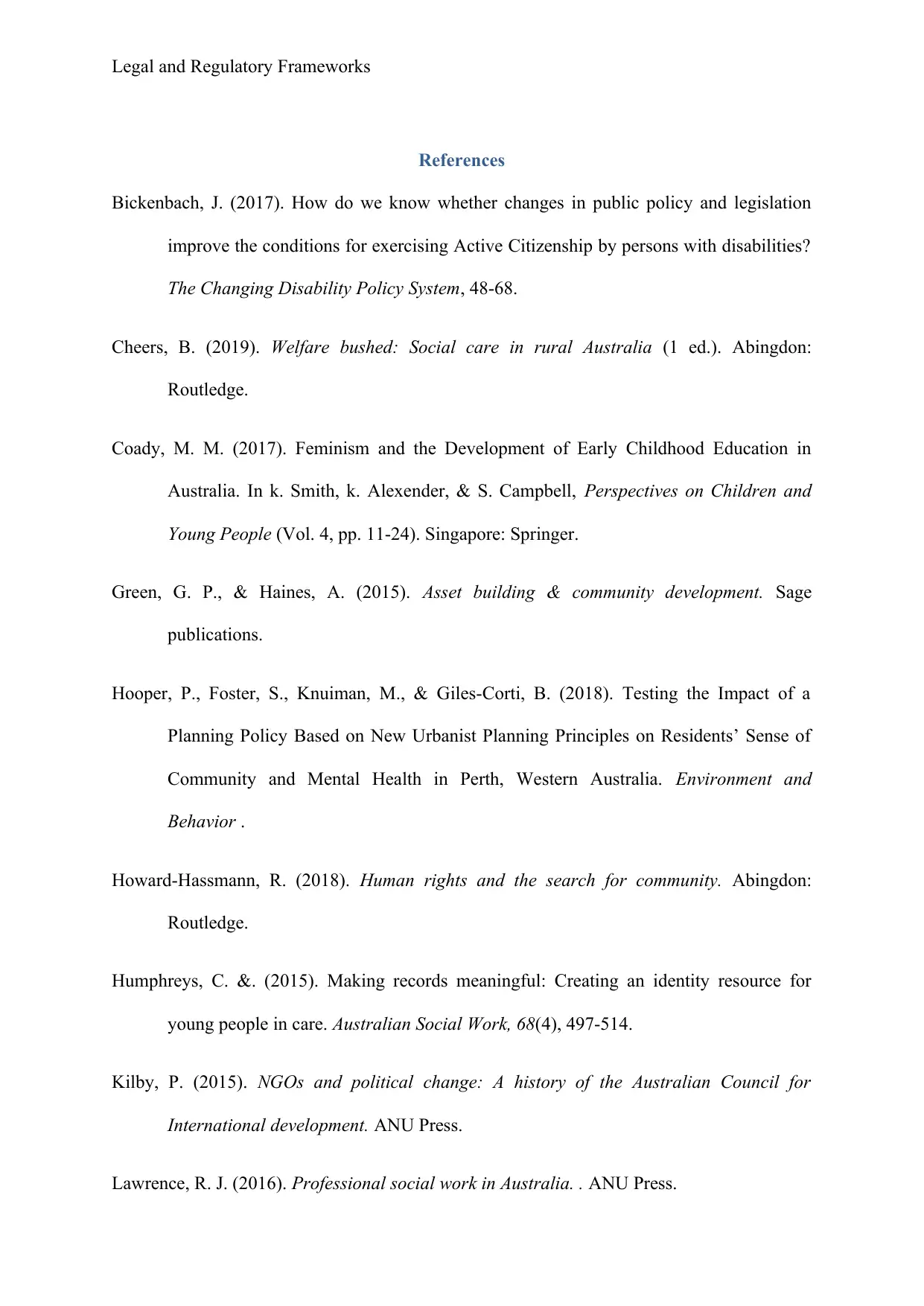
Legal and Regulatory Frameworks
References
Bickenbach, J. (2017). How do we know whether changes in public policy and legislation
improve the conditions for exercising Active Citizenship by persons with disabilities?
The Changing Disability Policy System, 48-68.
Cheers, B. (2019). Welfare bushed: Social care in rural Australia (1 ed.). Abingdon:
Routledge.
Coady, M. M. (2017). Feminism and the Development of Early Childhood Education in
Australia. In k. Smith, k. Alexender, & S. Campbell, Perspectives on Children and
Young People (Vol. 4, pp. 11-24). Singapore: Springer.
Green, G. P., & Haines, A. (2015). Asset building & community development. Sage
publications.
Hooper, P., Foster, S., Knuiman, M., & Giles-Corti, B. (2018). Testing the Impact of a
Planning Policy Based on New Urbanist Planning Principles on Residents’ Sense of
Community and Mental Health in Perth, Western Australia. Environment and
Behavior .
Howard-Hassmann, R. (2018). Human rights and the search for community. Abingdon:
Routledge.
Humphreys, C. &. (2015). Making records meaningful: Creating an identity resource for
young people in care. Australian Social Work, 68(4), 497-514.
Kilby, P. (2015). NGOs and political change: A history of the Australian Council for
International development. ANU Press.
Lawrence, R. J. (2016). Professional social work in Australia. . ANU Press.
References
Bickenbach, J. (2017). How do we know whether changes in public policy and legislation
improve the conditions for exercising Active Citizenship by persons with disabilities?
The Changing Disability Policy System, 48-68.
Cheers, B. (2019). Welfare bushed: Social care in rural Australia (1 ed.). Abingdon:
Routledge.
Coady, M. M. (2017). Feminism and the Development of Early Childhood Education in
Australia. In k. Smith, k. Alexender, & S. Campbell, Perspectives on Children and
Young People (Vol. 4, pp. 11-24). Singapore: Springer.
Green, G. P., & Haines, A. (2015). Asset building & community development. Sage
publications.
Hooper, P., Foster, S., Knuiman, M., & Giles-Corti, B. (2018). Testing the Impact of a
Planning Policy Based on New Urbanist Planning Principles on Residents’ Sense of
Community and Mental Health in Perth, Western Australia. Environment and
Behavior .
Howard-Hassmann, R. (2018). Human rights and the search for community. Abingdon:
Routledge.
Humphreys, C. &. (2015). Making records meaningful: Creating an identity resource for
young people in care. Australian Social Work, 68(4), 497-514.
Kilby, P. (2015). NGOs and political change: A history of the Australian Council for
International development. ANU Press.
Lawrence, R. J. (2016). Professional social work in Australia. . ANU Press.
Paraphrase This Document
Need a fresh take? Get an instant paraphrase of this document with our AI Paraphraser
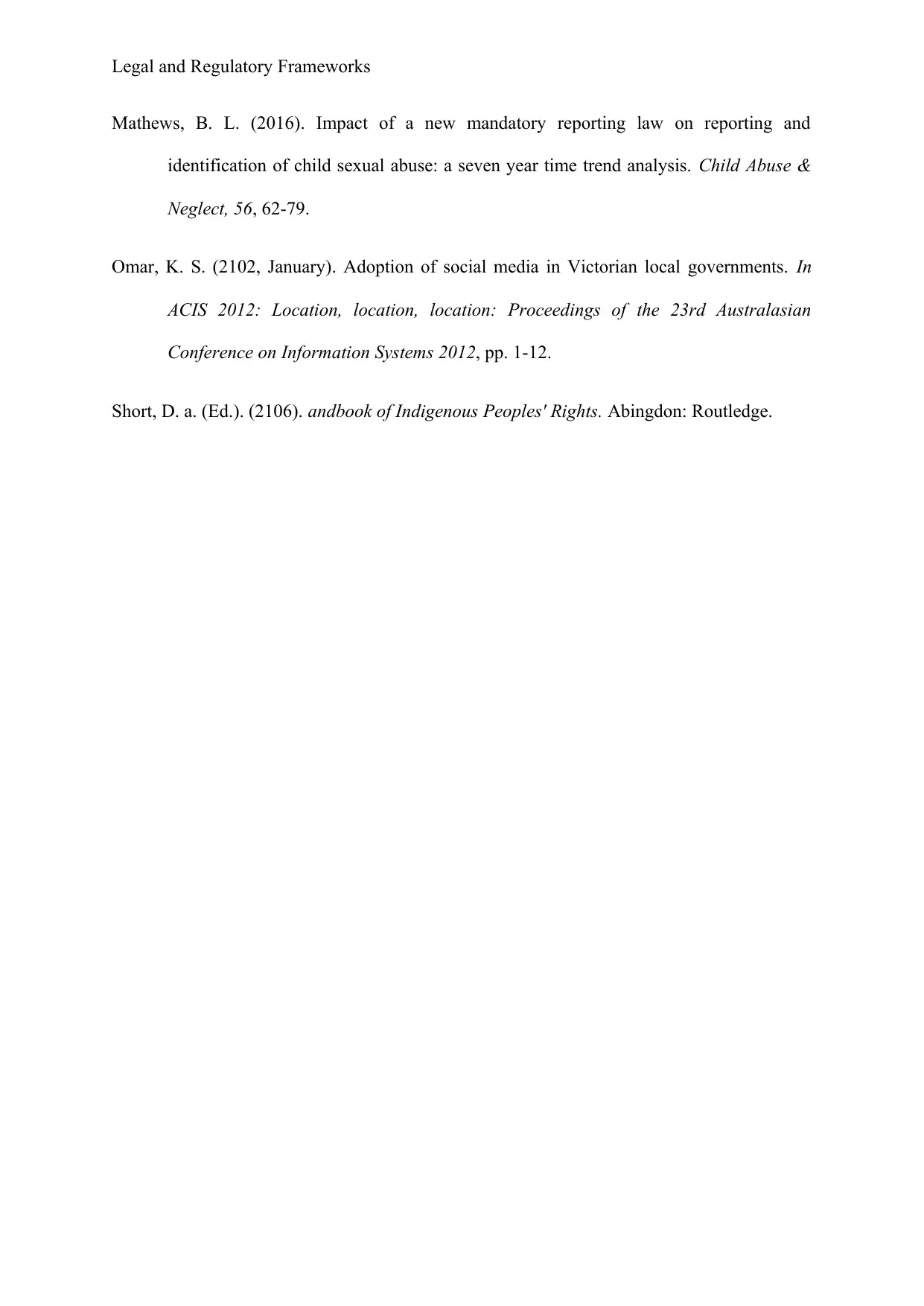
Legal and Regulatory Frameworks
Mathews, B. L. (2016). Impact of a new mandatory reporting law on reporting and
identification of child sexual abuse: a seven year time trend analysis. Child Abuse &
Neglect, 56, 62-79.
Omar, K. S. (2102, January). Adoption of social media in Victorian local governments. In
ACIS 2012: Location, location, location: Proceedings of the 23rd Australasian
Conference on Information Systems 2012, pp. 1-12.
Short, D. a. (Ed.). (2106). andbook of Indigenous Peoples' Rights. Abingdon: Routledge.
Mathews, B. L. (2016). Impact of a new mandatory reporting law on reporting and
identification of child sexual abuse: a seven year time trend analysis. Child Abuse &
Neglect, 56, 62-79.
Omar, K. S. (2102, January). Adoption of social media in Victorian local governments. In
ACIS 2012: Location, location, location: Proceedings of the 23rd Australasian
Conference on Information Systems 2012, pp. 1-12.
Short, D. a. (Ed.). (2106). andbook of Indigenous Peoples' Rights. Abingdon: Routledge.
1 out of 11
Related Documents
Your All-in-One AI-Powered Toolkit for Academic Success.
+13062052269
info@desklib.com
Available 24*7 on WhatsApp / Email
![[object Object]](/_next/static/media/star-bottom.7253800d.svg)
Unlock your academic potential
Copyright © 2020–2025 A2Z Services. All Rights Reserved. Developed and managed by ZUCOL.





